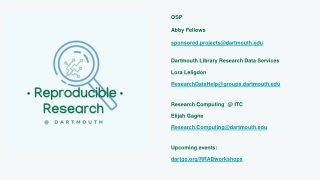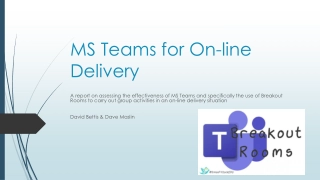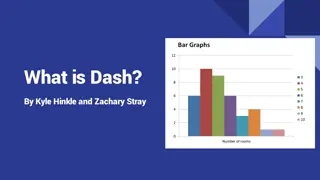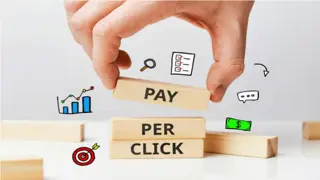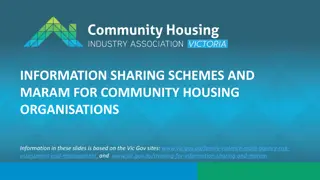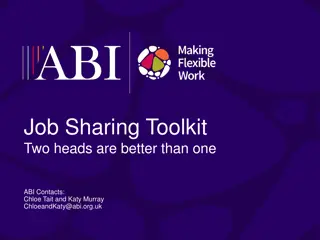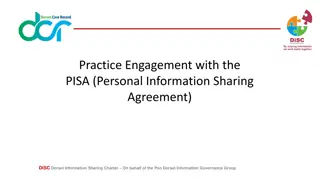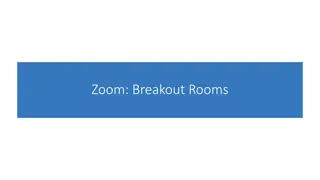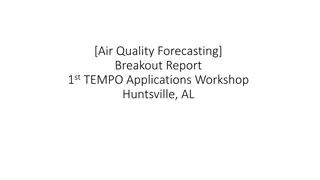DaSH: BREAKOUT - How to Encourage Data Sharing
Encouraging data sharing is vital for collaboration and innovation. This piece explores strategies and insights shared by experts in the field to foster a culture of openness and cooperation. Learn from the experiences and advice of Shanthi Gopalakrishnan, Cesar Bandera, Dantong Yu, Rene Baston, Ari Brooks, Chennuru Ashok, Shridar Ganesan, Ram Ramesh, and Heng Xu on the importance and benefits of sharing data in today's interconnected world.
Download Presentation

Please find below an Image/Link to download the presentation.
The content on the website is provided AS IS for your information and personal use only. It may not be sold, licensed, or shared on other websites without obtaining consent from the author.If you encounter any issues during the download, it is possible that the publisher has removed the file from their server.
You are allowed to download the files provided on this website for personal or commercial use, subject to the condition that they are used lawfully. All files are the property of their respective owners.
The content on the website is provided AS IS for your information and personal use only. It may not be sold, licensed, or shared on other websites without obtaining consent from the author.
E N D
Presentation Transcript
DaSH: BREAKOUT ``How to Encourage Data Sharing Scribe: Shanthi Gopalakrishnan Scribe: Cesar Bandera Dantong Yu Rene Baston Ari Brooks Chennuru, Ashok Shridar Ganesan Ram Ramesh Heng Xu
What data are relevant to healthcare, who are the owners who are the potential data users Stakeholders: Physician (who will pay high cost (time) - target them), Insurance companies (Profit Motive), primary care and hospital, IPA (independent practice association), patients (quality of care), Billing, (for smooth processing across multiple entities), and Researchers (for discovery) Who owns data: PC Data - 50% are owned by IPA, 30% owned by Multiple Specialists. Only 10% from hospital (ER) Users: care providers, research scientists Data example: clinic data, genomic data, epidemiological data, and healthcare data in a broad sense Definition: Data Publisher sharing with the user. Data Sharing without data exchange (allow research to submit data analysis algorithm and provide results). Access to higher level Meta data, Secondary Use of data - For Research. Primary Use of Data
Types of Data Sharing Data sharing among care providers to facilitate decision making (primary care, specialist, major hospital), medical records are the type of data to be shared General data sharing by researcher for knowledge discovery (Social objective) These two types of sharing ultimately serve the objectives (Reduce the cost of health care and improve the care of patients). To ensure sustained data sharing (and its supporting exchange point), there needs to be a sustainable business model for information exchange. The government can request it, but government incentives were not very effective and will not be extended.
Examples of Data Sharing Healthy Link - Online Platform in Western NY. Major hospital systems, Labs, Radiologists are members of the exchange. The records can also be manually accessed. All medical records will be available through the EMR system. PCP, radiology, labs, insurance are shared by firms and specialists. There are six levels of access and control- from anyone can access to banning access to specific parties. Informed consent - Patients do want to grant public access to the data. Multi-sided platform - Each side has to pay for the services that they use. Insurance company are the ultimate users. Market Penetration - 9000 Physicians 95% of the physicians are members. $100/year membership. Physicians use it for lab results.
Barrier, Challenges and difficulties for data sharing Intellectual Property Not fully interoperable Risk mitigation, aversion from Legal aspects. Least risky data sharing is no data sharing Privacy and Security w.r.t. healthcare data Commercial Values , Cost associated, care providers are busy dealing with patients, financial cost to support data sharing and exchange Steep learning curve for anyone to share. Variation in Data quality
Barrier, Challenges and difficulties for data sharing Availability of data Lack of trust on data source, for example, ER care does not trust data from paramedics, in particular interpreted data. Technical difficulties of sharing (large) data. Volume of information is going to explode. Seven million are newly enrolled in Obamacare, 1.4 million - Anthem (Well Point). Will a data sharing system be scalable to handle this big data? Must be put into private cloud for data security. Interoperability. Data breach vulnerability Regulation is an interoperability barrier. Lawyers control the information from provider #1 that provider #2 can see across an exchange. Pharmaceutical companies have high quality data as well. Should the government obligate them to share their clinical trial data? (need to provide data for drug approval).
Incentives for data sharing (encourage sharing): Better quality of care at lower cost Value proposition for the Insurance Company Shared Risk arrangement - Insurer and Provider equally at risk. Reduce costs Minimize duplicated tests Reduce potential abuse to health care (some comments that the healthy link can be potentially abused
Incentives for data sharing (encourage sharing): Better quality of care at lower cost Data quality control, Improved analysis, control group v.s. target group. Risk mitigation for patient and cost reductions (no need to repeat for the same medical tests). More efficient operations via better data sharing. Doctors use the gateways to access lab results (value of the data). Can data author increase her/his index by publishing data into several popular data repositories, for example UCI Machine Learning Repository? Mistrust of external data sources and analysis results Action items. Two models: staff care manager (coordinator) for regional clinics and nurses at the PCP, and hotspotters for high cost and high-interest patients with rare clinic case. Value based models, providers will be rewarded for uploading high-quality data and add values to exchange point in return for paying less fee for participation Demonstrate the value chain to get insurance company to get them to sponsor the exchange point. For example, show the number of claims to decrease, and show that constituents (payers and providers, members) all benefit.
Examples of successful data sharing: Electronic Health Information Exchange (HIE) is being effectively used in ER. HIE results in a better ER care - reduced repeat visits to ER and reduced hospital admissions.
Findings Unstructured data becomes norm in data collection (for example, doctor notes). Reduce risk aversion (by lawyers) that impedes data sharing between institutions. Risk management is NOT risk aversion. Data sharing is helped by the former but is impeded by the latter. Mistrust of data source is another obstacle to data sharing (in the case where the data owner is willing to share). Data quality is a key factor to be considered in seamless data integration
Principles for Data Sharing Quality of Data Clear demarcation of data for research and data for care Reduce the barriers to sharing Relative risk analysis with data literacy training
Recommendations for building an incentive- driven ecosystem towards data sharing Bring in risk analysis and provide general data literacy training for real issues, and facilitate decision making with balanced risks and benefits. EMR involves administrators and lawyers, and use a labor-intensive process (scan and fax) to get medical record. Need to ease the chain of getting approval. No proprietary form. General form needs to be introduced. (FHIR) Empower patient to access and view data. Put patience into the loop. Introduce (human or computer-aided ) data brokers. Selectively share patients data and minimize the burden of data owners (sampling) Implement Blue button to export patient records, digitally share data Raw, interpreted, meta data. Adopt open data format, ``standard , and ontology for interoperability.
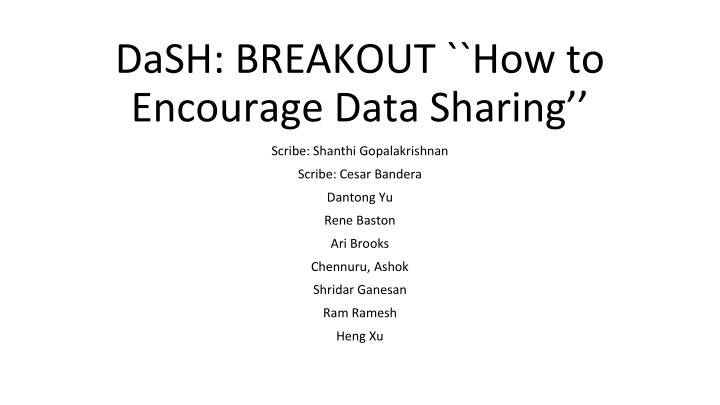

![READ [PDF] Dash diet Cookbook for beginners: 365 days of simple, healthy, low-s](/thumb/2057/read-pdf-dash-diet-cookbook-for-beginners-365-days-of-simple-healthy-low-s.jpg)
